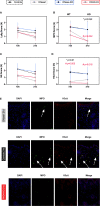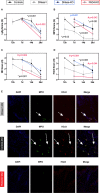Therapeutic Targeting of Neutrophil Extracellular Traps Improves Primary and Secondary Intention Wound Healing in Mice
- PMID: 33717100
- PMCID: PMC7947714
- DOI: 10.3389/fimmu.2021.614347
Therapeutic Targeting of Neutrophil Extracellular Traps Improves Primary and Secondary Intention Wound Healing in Mice
Abstract
Background: Neutrophils are the first responders in wound healing after injury that mediate pro- and anti-inflammatory activities i.a. through the formation of extracellular traps (NETs). However, excessive NETs presence in wound tissue can cause local hyperinflammation and -coagulation resulting in delayed wound healing. To improve wound healing, we aimed to examine the role of NETs and DNase1 on primary and secondary wound healing.
Methods: The study included 93 C57BL/6 mice, with 3 different genotypes: wildtype, Pad4-, and DNase1-Knockout (KO). Pad4-KO mice show limited NETs formation, while DNase1-KO mice cannot disintegrate them. All 3 genotypes were included in (1) a laparotomy group and (2) a thermal injury group. Animals in both groups either received DNase1 or a vehicle i.p. post wound induction and wound assessment and euthanasia were conducted. Laparotomy and burn scars were assessed using the stony brook scar evaluation scale and modified Yeong scale respectively. Tissue was analyzed histologically using H&E staining. Ly6g, Collagen I and III, SMA, and Fibrinogen were visualized and neutrophils activation (NE, MPO) and NETs (H3cit) formation assessed.
Results: All animals survived with no complications. DNase1 treatment led to a significantly improved scar appearance in both groups, which was also seen in Pad4-KO mice. In the laparotomy group DNase1 improved collagen deposition and fibrin concentration was significantly reduced by DNase1 treatment. Markers of neutrophil activation were significantly reduced in the treatment and Pad4-KO group. In the thermal injury group wound closure time was significantly reduced after DNase1 treatment and in the Pad4-KO group. Even though inflammation remained high in the thermal injury model over time, neutrophil activation and NETs formation were significantly reduced by DNase1 treatment compared to controls.
Discussion: Primary and secondary intention wound healing is improved by targeting NETs through DNase1 treatment or genetic KO, as assessed by wound closure time and scar appearances. Additionally, wound stability was not affected by DNASE treatment. The results suggest that overall wound healing is accelerated and DNase1 appears to be a promising option to reduce scar formation; which should be evaluated in humans.
Keywords: DNases; burns; neutrophil extracellular traps; scars; wound healing.
Copyright © 2021 Heuer, Stiel, Elrod, Königs, Vincent, Schlegel, Trochimiuk, Appl, Reinshagen, Raluy and Boettcher.
Conflict of interest statement
MB serves as a medical advisor of Neutrolis, Cambridge, MA, USA that focuses on developing therapies against NETs. MB is a stakeholder of Neutrolis. No compounds from Neutrolis were used in this study. The remaining authors declare that the research was conducted in the absence of any commercial or financial relationships that could be construed as a potential conflict of interest.
Figures




References
Publication types
MeSH terms
Substances
LinkOut - more resources
Full Text Sources
Other Literature Sources
Molecular Biology Databases
Research Materials
Miscellaneous

